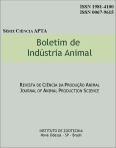Milk production in goats feed increasing levels of ramie (Boehmeria nivea, Gaud)
Keywords:
goats, ramic, elephant-grass cv. GuaçuAbstract
A trial to verify the most adequate level of ramie in the diet of lactating goats was performed. Eight crossbred anglonubian x alpine goats at the same lactating stage were used, in a 4x4 latin square design, testing the substitution of the elephant-grass cv. Guaçu, with levels of 0,34,66 and 100% in terms of the dry matter (DM) of the roughage. the higher use of ramie in the diet, the lower the liveweight gain (P< 0.01). The milk yield followed a quadratic regression equation (P< 0.05) begining with 13.56kg (without ramie) increasing up to 15.59 kg/period, at the level of 57% of ramie in the roughage. The same kind of response (P< 0.01) was observed for CP intake. The maximum level of DM intake occured with 84% and for CF with only 25% of ramie in the roughage. The level of crude energy intake did not vary significantly (P= 0.0513) but followed the same shape observed for CP. Fat, CP and milk total solids, as well as pH and N-NH4 in ruminal liquid were not influenced (P> 0.05) by ramie levels. The diet with 66% of ramie resulted in an increase of 14.9% in milk production in relation to treatment control.Downloads
Downloads
Published
Issue
Section
License
Os autores não serão remunerados pela publicação de trabalhos, pois devem abrir mão de seus direitos autorais em favor deste periódico. Por outro lado, os autores ficam autorizados a publicar seus artigos, simultaneamente, em repositórios da instituição de sua origem, desde que citada a fonte da publicação original seja Boletim de Indústria Animal. A revista se reserva o direito de efetuar, nos originais, alterações de ordem normativa, ortográfica e gramatical, com vistas a manter o padrão culto da língua e a credibilidade do veículo. Respeitará, no entanto, o estilo de escrever dos autores. Alterações, correções ou sugestões de ordem conceitual serão encaminhadas aos autores, quando necessário. Nesses casos, os artigos, depois de adequados, deverão ser submetidos a nova apreciação. As opiniões emitidas pelos autores dos artigos são de sua exclusiva responsabilidade. Todo o conteúdo deste periódico, exceto onde está identificado, está licenciado sob a Licença Creative Commons Attribution (CC-BY-NC). A condição BY implica que os licenciados podem copiar, distribuir, exibir e executar a obra e fazer trabalhos derivados com base em que só se dão o autor ou licenciante os créditos na forma especificada por estes. A cláusula NC significa que os licenciados podem copiar, distribuir, exibir e executar a obra e fazer trabalhos derivados com base apenas para fins não comerciais.













